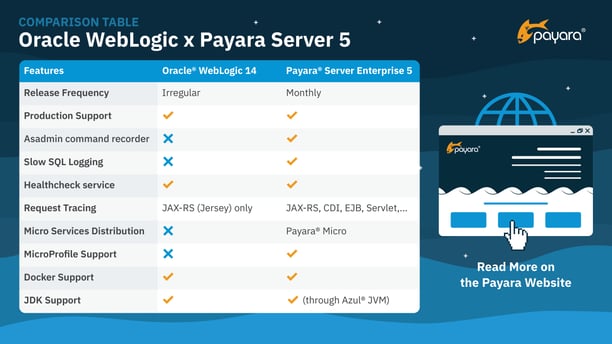Benefits of Migrating from Oracle WebLogic 14 to Payara Server Enterprise
Originally published on 01 Oct 2020
Last updated on 01 Mar 2021
 by Debbie Hoffman
by Debbie Hoffman
Payara Server Enterprise 5 is a cloud-native middleware application platform supporting mission critical production systems with reliable and secure deployments of Jakarta EE (Java EE) applications on premise, in the cloud, or hybrid environments. If you’ve been running WebLogic in production but are struggling with an infrequent release schedule, bug fixes, and patches - or if you want support for Eclipse MicroProfile, you’ll benefit from migrating from WebLogic to Payara Server Enterprise.
Migrate with Ease
The Oracle WebLogic Server is built around the Java EE specifications. Since both WebLogic 14 and Payara Server Enterprise 5 are based on the same version of the Java EE specification, the migrating process for Java EE applications from WebLogic to Payara Server Enterprise should be straightforward. When your applications in WebLogic are not using any implementation specific features and are only using the standard available features of the Java EE Specifications, the application will run without any modifications required.
The Migrating from WebLogic 14 to Payara Server 5 Enterprise Migration Guide gives you an overview of Oracle WebLogic 14 features and what the equivalent feature of the Payara Server is – or how you can achieve the same end result.
(If you’re running WebLogic 12, use the Migrating from WebLogic 12r2 to Payara Server Enterprise 5 Migration Guide instead).

If you’re planning to run Payara Server in production, you need the Payara Server Enterprise Edition - our fully supported and stable software designed for production Jakarta EE applications. You can choose our Migration & Project Support option for additional support during your migration process, and later move to a 24x7 or 10x5 support plan when running Payara Server in your production environment.

Benefits of Migrating to Payara Server Enterprise
Now that you know migrating from WebLogic to Payara Server Enterprise is relatively painless, and that Payara Server offers the same functionality as WebLogic - let’s go over some of the reasons you would want to migrate and the benefits you’ll experience after migration.
Release Frequency
WebLogic release frequency and component upgrades are irregular while Payara Server Enterprise is released monthly to ensure the security and stability of your applications.
JDK 8 and JDK 11
With the release of WebLogic 14c, JDK 11 is supported now, but it took them some time to catch up. Payara Server has officially supported JDK 11 since version 5.194, released in December 2019. This means that both JDK 8 and JDK 11 are supported by Oracle WebLogic 14c and Payara Server 5.
However, when using GraalVM as the JVM for running your platform, WebLogic is only supported on the Enterprise Edition of GraalVM and then only on Red Hat Enterprise Linux. Payara Server Enterprise on the other hand, runs fine, and is also supported on the GraalVM community edition. So, there is no need to buy licenses of the Enterprise GraalVM platform as required to run Oracle WebLogic on the GraalVM JVM.
Payara Enterprise Customers have JDK support by Azul when using their JVM. Should you experience a JVM related issue, you can rely on your included support to find a suitable solution or get a fixed build. And as part of our long-term support for a specific version, JDK 8 security updates will also be available from Azul for our customers.
Request Tracing
With Request Tracing in Payara Server, you can identify which call to a RESTful endpoint takes a lot of time to process. When multiple endpoints are called in a chain to perform the operation, one can identify which of those calls is the bottleneck.
With WebLogic, you can only use the provided functionality of the Jersey framework for this purpose. Payara Server Enterprise goes much further with the Request Tracing Feature. The Payara Request Tracing does not just trace the call to the REST endpoint but takes note of the time it spends in EJB bean methods, CDI bean methods and Servlets amongst others when they have the @Traced annotation. All this information is written through the Notification Service so that finding what part of the request is the bottleneck becomes much easier.
Features Available in Payara Server Enterprise
In addition to more frequent releases, security fixes, and component upgrades, migrating to Payara Server Enterprise from WebLogic also gives you access to the following features that are not currently included with WebLogic:
- Jakarta EE Compatibility
- Asadmin command recorder
- Additional notification channels: CDI, Slack, New Relic, Datadog
- Slow SQL Logging
- Native support for OAuth2/OpenId Connect
- Microservices distribution (Payara Micro)
- MicroProfile support
- Uber-jar and Hollow Jar
View our complete WebLogic 14 vs. Payara Server Enterprise 5 Comparison Table for a side-by-side feature comparison.

All things considered, migrating from WebLogic to Payara Server Enterprise should be an easy and painless process. Once migrated, you’ll have access to a variety of new features provided by Payara Server, MicroProfile, and Jakarta EE 8 APIs to further optimize your applications.
Related Posts
JBoss EAP 7 End of Support: What Java Developers Need to Know (And What to Do Next)
Published on 15 Aug 2025
by Chiara Civardi
0 Comments
SIFMA Foundation Scales and Modernizes Financial Literacy Platform with Payara Services
Published on 21 Jul 2025
by Chiara Civardi
0 Comments

